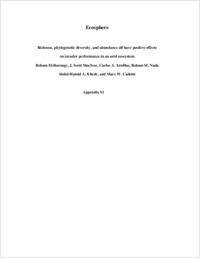Richness, phylogenetic diversity, and abundance all have positive effects on invader performance in an arid ecosystem
- El-Barougy, Reham F. Department of Botany and Microbiology Faculty of Science Damietta University Damietta Egypt - Department of Biology University of Fribourg Avenue de l'Europe 20 Fribourg 1700 Switzerland
- Mac, Ivor, J. Scott Department of Biological Sciences University of Toronto Scarborough 1265 Military Trail Toronto Ontario Canada
- Arnillas, Carlos A. Department of Physical and Environmental Sciences University of Toronto Scarborough 1265 Military Trail Toronto Ontario Canada
- Nada, Reham M. Department of Botany and Microbiology Faculty of Science Damietta University Damietta Egypt
- Khedr, Abdel‐Hamid A. Department of Botany and Microbiology Faculty of Science Damietta University Damietta Egypt
- Cadotte, Marc W. Department of Biological Sciences University of Toronto Scarborough 1265 Military Trail Toronto Ontario Canada - Department of Ecology and Evolutionary Biology University of Toronto 25 Willcocks Street Toronto Ontario Canada
-
01.02.2020
Published in:
- Ecosphere. - 2020, vol. 11, no. 2, p. e03045
English
In search of generalities in biological invasions, it is sometimes forgotten that invader success can be a function of both the diversity of the invaded community and the relatedness of the invader relative to community residents. Both qualities are likely to be especially important in stressful ecosystems, and identifying the species and community attributes that influence biological invasions can help direct management efforts in a sensitive ecosystem like those in arid regions. Pink Morning Glory, Ipomoea carnea Jaq. (Family: Convolvulaceae), is an annual vine native to Central and South America and is invasive in Egypt. We examined the performance of I. carnea at different densities in assembled communities of Egyptian annual native species. The native plant communities were manipulated to represent gradients of species richness and phylogenetic diversity and relatedness to I. carnea . We quantified the performance of I. carnea in these communities and examined the contribution of resident species richness, phylogenetic diversity, and phylogenetic relatedness to invader resistance. Our findings revealed that there was a positive relationship between invader performance and its mean phylogenetic distance to the resident species. Furthermore, species‐rich communities with more distantly related species positively contributed to invader performance in contrast to the classic biotic resistance hypothesis. Beyond these positive relationships, a positive density‐dependent effect of I. carnea on its performance was observed. We conclude that facilitative interactions are potentially important drivers promoting the successful invasion of the nonnative species I. carnea in water‐limited and harsh ecosystems. These results suggest that perhaps contrary to understanding from temperate systems, communities with a higher diversity of species could be more likely to be invaded by arid‐adapted species that are distantly related to natives. Thus, policy and management in arid regions should carefully consider reviewing the importation of nonnative species that are phylogenetically distinct and adapted to arid conditions and prioritizing their control once they are established.
- Faculty
- Faculté des sciences et de médecine
- Department
- Département de Biologie
- Language
-
- English
- Classification
- Biological sciences
- License
-
License undefined
- Identifiers
-
- RERO DOC 328517
- DOI 10.1002/ecs2.3045
- Persistent URL
- https://folia.unifr.ch/unifr/documents/308557
Other files
Statistics
Document views: 102
File downloads:
- pdf: 240
- Supplementary material: 123

